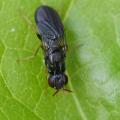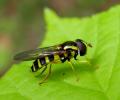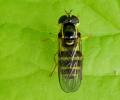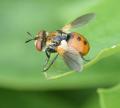|
Spectacular Eumerus from Greece (E. niveitibia)
|
|
| Gerard Pennards |
Posted on 20-07-2008 13:48
|
|
Member Location: Posts: 1914 Joined: 07.06.04 |
This is a spectacular Eumerus I caught on the Island of Zakynthos in Greece. It was only found on the highest point of the Island (Mt Vrachionas, 756 meters), and very difficult to catch. Strong and fast flyer, only sitting on some bigger rocks once in a while. Big species, more than 10 mm, and as you can see it's metallic blue. On the abdomen there are the typical white Eumerus spots (not well visible on the pictures), and the animal has a lot of longer white hairs on the abdomen and legs, whereas on the thorax it has longer black hairs. I only saw males, and of those a caught a few. Does anyone know this species? Greetings, Edited by Gerard Pennards on 23-07-2008 08:51 Greetings, Gerard Pennards |
|
|
|
| Gerard Pennards |
Posted on 20-07-2008 13:49
|
|
Member Location: Posts: 1914 Joined: 07.06.04 |
And a picture of the abdomen
Greetings, Gerard Pennards |
|
|
|
| Gerard Pennards |
Posted on 23-07-2008 08:50
|
|
Member Location: Posts: 1914 Joined: 07.06.04 |
After mailing some people to look at this species I got a message of Claus Claussen, Gerrmany, that this is for sure a male of Eumerus niveitibia Becker 1921. Thanks very much Claus! Greetings Greetings, Gerard Pennards |
|
|
|
| jorgemotalmeida |
Posted on 23-07-2008 10:53
|
|
Member Location: Posts: 9295 Joined: 05.06.06 |
blue metallic syrphid!  |
|
|
|
| Gerard Pennards |
Posted on 23-07-2008 19:31
|
|
Member Location: Posts: 1914 Joined: 07.06.04 |
Fly in natural surroundings
Greetings, Gerard Pennards |
|
|
|
| Gerard Pennards |
Posted on 23-07-2008 19:31
|
|
Member Location: Posts: 1914 Joined: 07.06.04 |
Full size
Greetings, Gerard Pennards |
|
|
|
| Maddin |
Posted on 24-07-2008 20:59
|
|
Member Location: Posts: 193 Joined: 30.06.05 |
Of course Claus is right again, this is close or identical with nivetibia. This is really an awesome and very rare species. I have one from Spain in my collection and also the type of Eumerus bayardi belongs to this group. I have not done a detailed comparison, but it could well be that there are at least 3 species involved, because there are some differences in color etc between the specimens...I try to post my pics of the type. Cheers Martin Martin Hauser |
|
|
|
| Andre |
Posted on 25-07-2008 14:17
|
|
Member Location: Posts: 2111 Joined: 18.07.04 |
Do you have detailed pics of the tibia? |
|
|
|
| Gerard Pennards |
Posted on 27-07-2008 21:39
|
|
Member Location: Posts: 1914 Joined: 07.06.04 |
Hmmm, not yet, why do you want to look at hte tibia? Is there a difference between bayardi and niveitibia, or do you just want to see why it's called niveitibia? Greetings Greetings, Gerard Pennards |
|
|
|
| Andre |
Posted on 28-07-2008 21:31
|
|
Member Location: Posts: 2111 Joined: 18.07.04 |
Yes. |
|
|
|
| Lukasz Mielczarek |
Posted on 12-11-2010 12:57
|
|
Member Location: Posts: 498 Joined: 27.09.06 |
I have two similar specimens of blue metallic Eumerus from Bulgaria collected near Burgas. Eumerus niveitibia? |
|
|
|
| Lukasz Mielczarek |
Posted on 12-11-2010 12:58
|
|
Member Location: Posts: 498 Joined: 27.09.06 |
... |
|
|
|
| Gerard Pennards |
Posted on 13-11-2010 11:33
|
|
Member Location: Posts: 1914 Joined: 07.06.04 |
Hey Lukasz, Nice catch! Yes, it could be E. niveitibia, but in this group there are at least two other species I'm aware of. One is Eumerus ovatus, which has bare eyes and some red patches (sometimes very small) at the abdomen. The other one is Eumerus bayardi, of which the main feature is that the eyes in the male meet in one point! But this species also seems to have some reddish brown patches on tergites 3 or 4. Your specimen seems to be less hairy than my niveitibia's, and also the metallic sheen seems different. So my guess is that it is bayardi or ovatus, but I'm not sure! I was still planning (together with Martin Hauser (Maddin)) to take a better look at this group, because it seems there could be more species involved. If so, maybe we would ask you to lend us your specimens for study. Naturally, you'll get them back when we're finished! Greetings, Gerard Greetings, Gerard Pennards |
|
|
|
| PIERRE MILLE |
Posted on 13-11-2010 15:12
|
|
Member Location: Posts: 72 Joined: 12.12.09 |
Hello every one, Gerard and Lukasz hoverflies are beautiful, I personally have never seen the like! In the book of Van Veen, most are thermophilous and can be found in grasslands and at the borders of woods and bushes, often near the larval food plants, most speciesfly quickly near the ground, which makes them difficult to spot et the larvae mine through bulbs and are considered pests in commercial bulb plantations. In the book of Verlinden the Mesonotum and abdomen with short straight lines or arcs pruinisité gray or silver wing MP1a recurrent femur 3 more or less thickened, the lower face provided with spines on the apical half, flat face covered with long hairs directed downwards and larvae live in the bulbs and rhizomes of some Liliaceae, Asteraceae. In the book Seguy "syrphid Diptera of Western Europe 1961" it is clear that adults and larvae anthophilous lucicoles and also live in the Amaryllis Orrobanchées observed and spurge Seguy divided into two groups, indicating that this cutoff is artificial casue of the apical dimple or rarely apically on the 3rd antennal some species. I searched the Syrph the Net, this is one of the largest syrphid genera in the Palaearctic region, with 140 species listed by Peck (1988). Unfortunately, the taxonomic status of a significant number of the species is uncertain and the nomenclature, of others is confused. More than 50 species have been recorded from Europe, most of them from southern, parts of the continent. There is no key in which all the known European species are included and the keys, which do exist, do not inspire confidence. The most comprehensive keys are those of Stackelberg (1961). Best wishes PIERRE http://cyrille.du...orange.fr/ http://www.hoverf...portal.php |
|
|
|
| Lukasz Mielczarek |
Posted on 14-11-2010 00:22
|
|
Member Location: Posts: 498 Joined: 27.09.06 |
Specimens have been collected in 1976 by Miroslaw Soszynski and are part of a larger and very interesting, mainly Balkan colection. I've never been in Bulgaria. I am convinced that this isn't E. ovatus. There are no red spots on the tergites in both specimens, the eyes are meet in greater length than one point, so not E. bayardi. Gerard, I can borrow specimens for you  Lukasz |
|
|
|
| Jump to Forum: |














